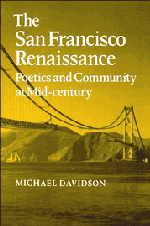2 - “The Darkness Surrounds Us”
Participation and Reflection among the Beat Writers
Published online by Cambridge University Press: 01 June 2011
Summary
BEFORE BEATITUDE
To most readers the “San Francisco Renaissance” and the “Beat movement” are synonymous. To be sure, the Beats provided the most public demonstration that some sort of literary ferment was occurring in the Bay Area. San Francisco was the city in which Lawrence Ferlinghetti first published many of the Beat generation writers through his City Lights editions and sold their books through his bookstore of the same name; it was the city in which Allen Ginsberg's “Howl” was written and where the book's subsequent censorship trial took place; it was the focal point for many of Jack Kerouac's novels; it was the site of bars and coffeehouses like The Cellar, The Place, and The Coexistence Bagel Shop, where poetry was read to jazz; and, finally, it was the city in which many members of the Beat generation lived for periods of time during the 1950s. Allen Ginsberg, Jack Kerouac, Lawrence Ferlinghetti, Michael McClure, Gary Snyder, Philip Whalen, Philip Lamantia, and others found themselves in San Francisco at some point during the crucial period of the 1950s.
Despite the obvious centrality of the Beat movement to the San Francisco literary scene, it was, as my other chapters will indicate, only one strand in a much more diverse and eclectic movement. Although poets like Jack Spicer, Robert Duncan, and Kenneth Rexroth at various times supported the Beats against the attacks of journalists and official censors, they often – and in print – expressed animosity toward the more excessive gestures of Ginsberg and company.
- Type
- Chapter
- Information
- The San Francisco RenaissancePoetics and Community at Mid-Century, pp. 60 - 94Publisher: Cambridge University PressPrint publication year: 1989



